Impact Fretting Wear of MoS2/C Nanocomposite Coating with Different Carbon Contents under Cycling Low Kinetic Energy
Abstract
:1. Introduction
2. Materials and Methods
3. Results
3.1. Coating Deposition and Chemical Composition
3.2. Dynamic Response of Impact Wear Test
3.3. Impact Wear Analysis
4. Conclusions
- (1)
- The distribution of the C, S, and Mo elements in the prepared MoS2/C coating was uniform, indicating that the surface properties of the composite coating were consistent. Meanwhile, the S/Mo content ratio was approximately 1.26. C doping increased the hardness and oxidation resistance of the MoS2 coating.
- (2)
- C doping increased the hardness of the coatings (6.4–12 Gpa), which further improved the wear resistance of the MoS2/C coatings.
- (3)
- When the target current of C was 3.5 A and the target current of MoS2 was 0.6 A (the carbon content was approximately 78.3%), the coating exhibited a good impact resistance in terms of dynamic response, including low energy absorption ratio and low impact force.
- (4)
- The wear scar and the volume loss analysis show that MoS20.6 has a good impact resistance and can protect the substrate. The wear mechanism of coatings presents fatigue delamination and spalling, which are caused by cyclic shear stress. In addition, frictional oxidation occurs, especially in the stratified zone.
Author Contributions
Funding
Data Availability Statement
Conflicts of Interest
References
- Park, W.; Min, J.W.; Shaikh, S.F.; Hussain, M.M. Stable MoS2 Field-Effect Transistors Using TiO2 Interfacial Layer at Metal/MoS2 Contact. Phys. Status Solidi A 2017, 214, 1770171. [Google Scholar] [CrossRef] [Green Version]
- Särhammar, E.; Strandberg, E.; Sundberg, J.; Nyberg, H.; Kubart, T. Mechanisms for compositional variations of coatings sputtered from a WS2 target. Surf. Coat. Technol. 2014, 252, 186–190. [Google Scholar] [CrossRef]
- Kim, S.S.; Ahn, C.W.; Kim, T.H. Tribological characteristics of magnetron sputtered MoS2 films in various atmospheric conditions. KSME Int. J. 2002, 16, 1065–1071. [Google Scholar] [CrossRef]
- Grosseau, J.L.; Moine, P.; Brendle, M. Shear strength measurements of parallel MoSx thin films. Thin Solid Film. 1997, 307, 163–168. [Google Scholar] [CrossRef]
- Buck, V. Preparation and properties of different types of sputtered MoS2 films. Wear 1987, 114, 263–274. [Google Scholar] [CrossRef]
- Remskar, M.; Jelenc, J.; Visic, B. Friction properties of polyviny lidene fluoride with added MoS2 nanotubes. Phys. Status Solidi A 2013, 210, 314–2319. [Google Scholar] [CrossRef]
- Meier, J.G.; Mrzel, A.; Canales, M.; Alcala, N. Tribological properties of composites of polyamide-6 and nanotubes of MoS2, and nanowires of MoO(3−x) and Mo6S2I8. Phys. Status Solidi A 2013, 210, 2307–2313. [Google Scholar] [CrossRef]
- Renevier, N.M.; Hamphire, J.; Fox, V.C. Advantages of using self-lubricating, hard, wear-resistant MoS2-based coatings. Surf. Coat. Technol. 2001, 142, 67–77. [Google Scholar] [CrossRef]
- Shyyko, L.; Kotsyubynsky, V.; Budzulyak, I.; Lisovski, R. Synthesis and double-hierarchical structure of MoS2/C nanospheres. Phys. Status Solidi A 2015, 212, 2309–2314. [Google Scholar] [CrossRef]
- Zhao, X.; Zhang, G.; Wang, L.; Xue, Q. The tribological mechanism of MoS2 film under different humidity. Tribol. Lett. 2017, 65, 64–69. [Google Scholar] [CrossRef]
- Vierneusel, B.; Schneider, T.; Tremmel, S.; Gradt, T. MoS2 coatings deposited by unbalanced magnetron sputtering. Surf. Coat. Technol. 2013, 235, 97–107. [Google Scholar] [CrossRef]
- Khare, H.S.; Burris, D.L. The effects of environmental water and oxygen on the temperature-dependent friction of sputtered molybdenum disulfide. Tribol. Lett. 2013, 52, 485–493. [Google Scholar] [CrossRef]
- Khare, H.S.; Burris, D.L. Surface and subsurface contributions of oxidation and moisture to room temperature friction of molybdenum disulfide. Tribol. Lett. 2014, 53, 329–336. [Google Scholar] [CrossRef]
- Chen, W.; Wang, Y.; Feng, C.F.; Zhang, L. Effect of hot extrusion on electrical tribological behavior of Ag-Cu/MoS2 composite under air and vacuum conditions. Tribol. Trans. 2016, 60, 653–662. [Google Scholar] [CrossRef]
- Selvakumar, N.; Narayanasamy, P. Optimization and effect of weight fraction of MoS2 on the tribological behavior of Mg-TiC-MoS2 hybrid composites. Tribol. Trans. 2017, 139, 733–747. [Google Scholar] [CrossRef]
- Lince, J.R. Tribology of co-sputtered nanocomposite Au/MoS2 solid lubricant films over a wide contact stress range. Tribol. Lett. 2004, 17, 419–428. [Google Scholar] [CrossRef]
- Singh, H.; Mutyala, K.C.; Mohseni, H.; Scharf, T.W.; Doll, G.L. Tribological performance and coating characteristics of sputter-deposited Ti-doped MoS2 rolling and sliding contact. Tribol. Trans. 2015, 58, 767–777. [Google Scholar] [CrossRef]
- Qin, X.P.; Ke, P.L.; Wang, A.Y.; Kim, K.H. Microstructure, mechanical and tribological behaviors of MoS2-Ti composite coatings deposited by a hybrid HIPIMS method. Surf. Coat. Technol. 2013, 228, 275–281. [Google Scholar] [CrossRef]
- Zhai, W.Z.; Shi, X.L.; Wang, M.; Xu, Z.S.; Zhang, Q.X. Friction and wear properties of TiAl-Ti3SiC2-MoS2 composites prepared by spark plasma sintering. Tribol. Trans. 2014, 57, 416–424. [Google Scholar] [CrossRef]
- Zabinski, J.S.; Donley, M.S.; Dyhouse, V.J.; McDevitt, N.T. Chemical and tribological characterization of PbO—MoS2 films grown by pulsed laser deposition. Thin Solid Film. 1992, 214, 156–163. [Google Scholar] [CrossRef]
- Zabinski, J.S.; Donley, M.S.; McDevitt, N.T. Mechanistic study of the synergism between Sb2O3 and MoS2 lubricant systems using Raman spectroscopy. Wear 1993, 165, 103–108. [Google Scholar] [CrossRef]
- Senthil, P.; Kumar, K.; Narayanasamy, R. Dry sliding friction and wear characteristics of Cu-Sn alloy containing molybdenum disulfide. Tribol. Trans. 2013, 56, 857–866. [Google Scholar] [CrossRef]
- Nyberg, H.; Sundberg, J.; Särhammar, E.; Jacobson, S. Extreme friction reductions during initial running-in of W–S–C–Ti low-friction coatings. Wear 2013, 302, 987–997. [Google Scholar] [CrossRef]
- Wu, Y.X.; Li, H.; Ji, L.; Zhou, H.D. Preparation and properties of MoS2/C films for space tribology. J. Phys. D Appl. Phys. 2013, 46, 5301. [Google Scholar] [CrossRef]
- Polcar, T.; Cavaleiro, A. Review on self-lubricant transition metal dichalcogenide nanocomposite coatings alloyed with carbon. Surf. Coat. Technol. 2011, 206, 686–695. [Google Scholar] [CrossRef]
- Lee, J.; Jang, H.; Kwak, T.; Nam, O. Comparison of MoS2/p-GaN Heterostructures Fabricated via Direct Chemical Vapor Deposition and Transfer Method. Phys. Status Solidi A 2020, 217, 1900722. [Google Scholar] [CrossRef]
- Nossa, A.; Cavaleiro, A. The influence of the addition of C and N on the wear behavior of W–S–C/N coatings. Surf. Coat. Technol. 2001, 142, 984–991. [Google Scholar] [CrossRef]
- Cai, S.; Guo, P.; Liu, J.Z.; Zhang, D.; Zhu, Y.J. Friction and wear mechanism of MoS2/c composite coatings under atmospheric environment. Tribol. Lett. 2017, 65, 79. [Google Scholar] [CrossRef]
- Shneider, M.; Rapoport, L.; Moshkovich, A.; Zak, A. Tribological performance of the epoxy-based composite reinforced by WS2 fullerene-like nanoparticles and nanotubes. Phys. Status Solidi A 2013, 210, 2298–2306. [Google Scholar] [CrossRef]
- Niakan, H.; Zhang, C.; Hu, Y.; Szpunar, J.A.; Yang, Q. Thermal stability of diamond-like carbon–MoS2 thin films in different environments. Thin Solid Film. 2014, 562, 244–249. [Google Scholar] [CrossRef]
- Gu, L.; Ke, P.; Zou, Y.; Wang, A.Y. Amorphous self-lubricant MoS2-C sputtered coating with high hardness. Appl. Surf. Sci. 2015, 331, 66–71. [Google Scholar] [CrossRef]
- Pimentel, J.V.; Polcar, T.; Cavaleiro, A. Structural, mechanical and tribological properties of Mo–S–C solid lubricant coating. Surf. Coat. Technol. 2011, 205, 3274–3279. [Google Scholar] [CrossRef]
- Xu, J.; Chai, L.Q.; Qiao, L.; He, T.F.; Wang, P. Influence of C dopant on the structure, mechanical and tribological properties of r.f.-sputtered MoS2/a-C composite films. Appl. Surf. Sci. 2016, 364, 249–256. [Google Scholar] [CrossRef]
- Lin, Y.W.; Cai, Z.B.; Chen, Z.Q.; Zhu, M.H. Influence of diameter–thickness ratio on alloy Zr-4 tube under low-energy impact fretting wear. Mater. Today Commun. 2016, 8, 79–90. [Google Scholar] [CrossRef] [Green Version]
- Wang, Z.; Cai, Z.B.; Sun, Y.; Peng, J.F.; Zhu, M.H. Low velocity impact wear behavior of MoS2/Pb nanocomposite coating under controlled kinetic energy. Surf. Coat. Technol. 2017, 326, 53–62. [Google Scholar] [CrossRef]
- Shang, K.D.; Zheng, S.X.; Ren, S.M.; Pu, J.B.; Liu, S. Improving the tribological and corrosive properties of MoS2-based coatings by dual-doping and multilayer construction. Appl. Surf. Sci. 2018, 437, 233–244. [Google Scholar] [CrossRef]
- Wang, L.L.; Wang, R.Y.; Fu, D.J. Structure and properties of Mo-containing diamond-like carbon films pro-duced by ion source assisted cathodic arc ion-plating. Appl. Surf. Sci. 2013, 286, 109–114. [Google Scholar] [CrossRef]
- Dupin, J.C.; Gonbeau, D.; Martin, I.; Levasseur, A. Amorphous oxysulfide thin films MOySz (M = W, Mo, Ti) XPS characterization: Structural and electronic peculiarities. Appl. Surf. Sci. 2001, 173, 140–150. [Google Scholar] [CrossRef]
- Bertóti, I.; Mohai, M.; Renevier, N.M.; Szilágyi, E. XPS investigation of ion beam treatedMoS2–Ti composite coatings. Surf. Coat. Technol. 2000, 125, 173–178. [Google Scholar] [CrossRef]
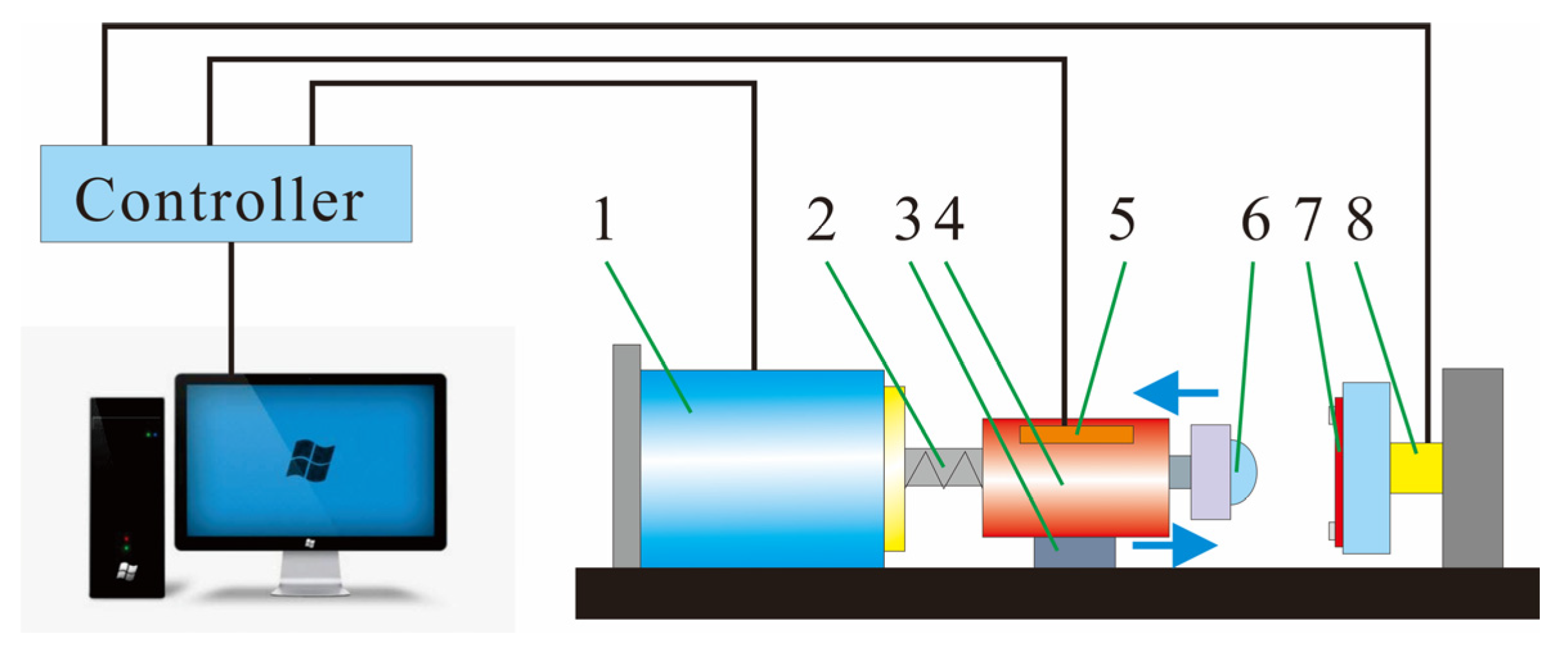
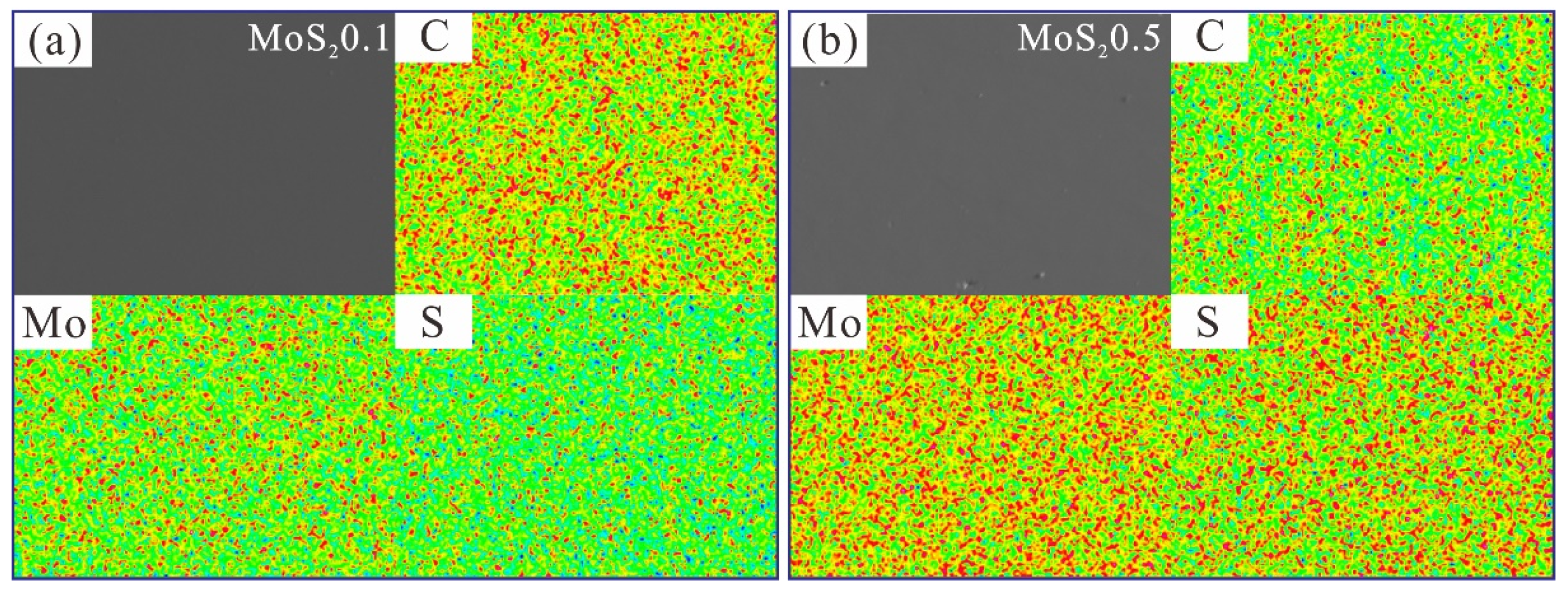



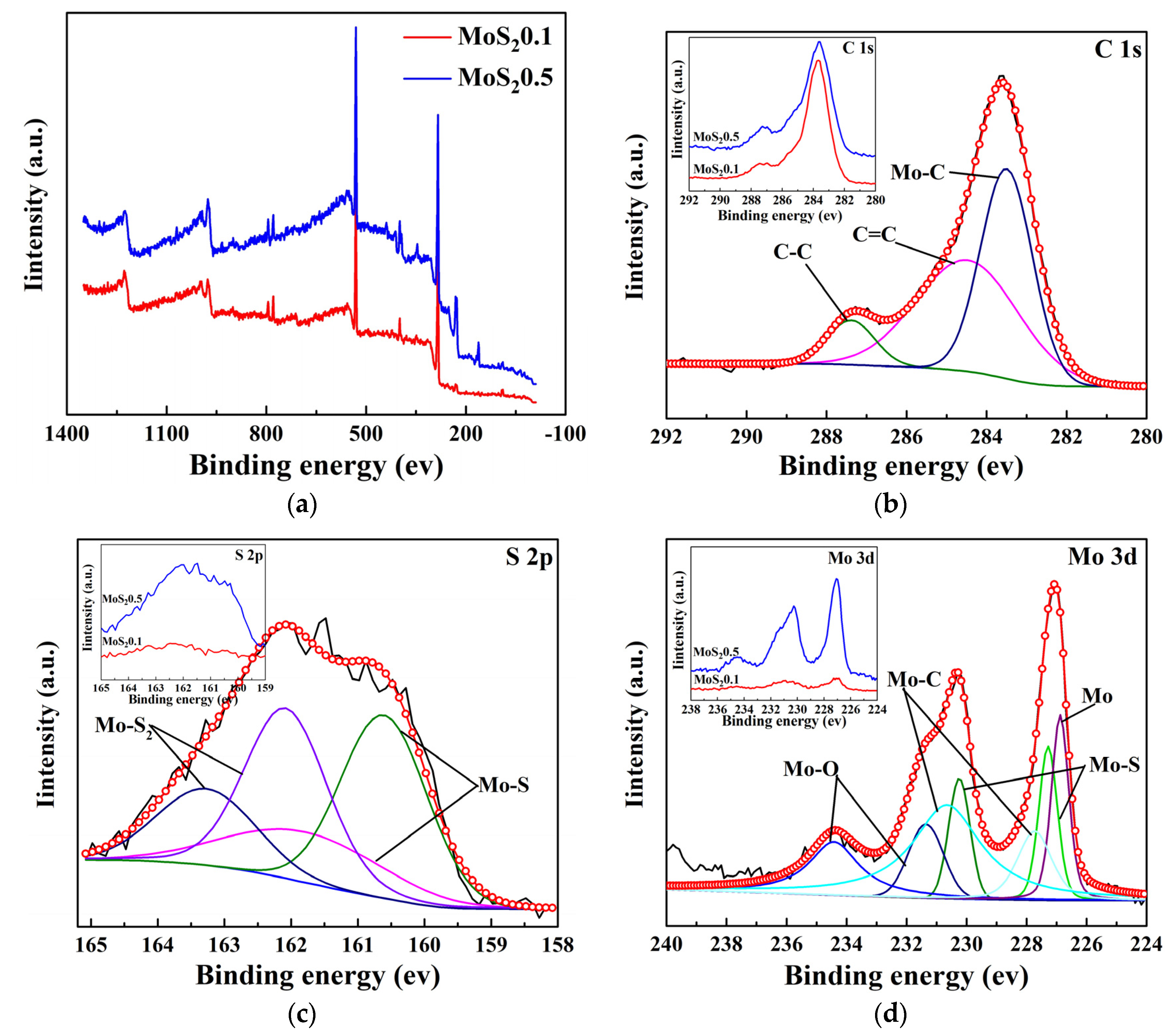
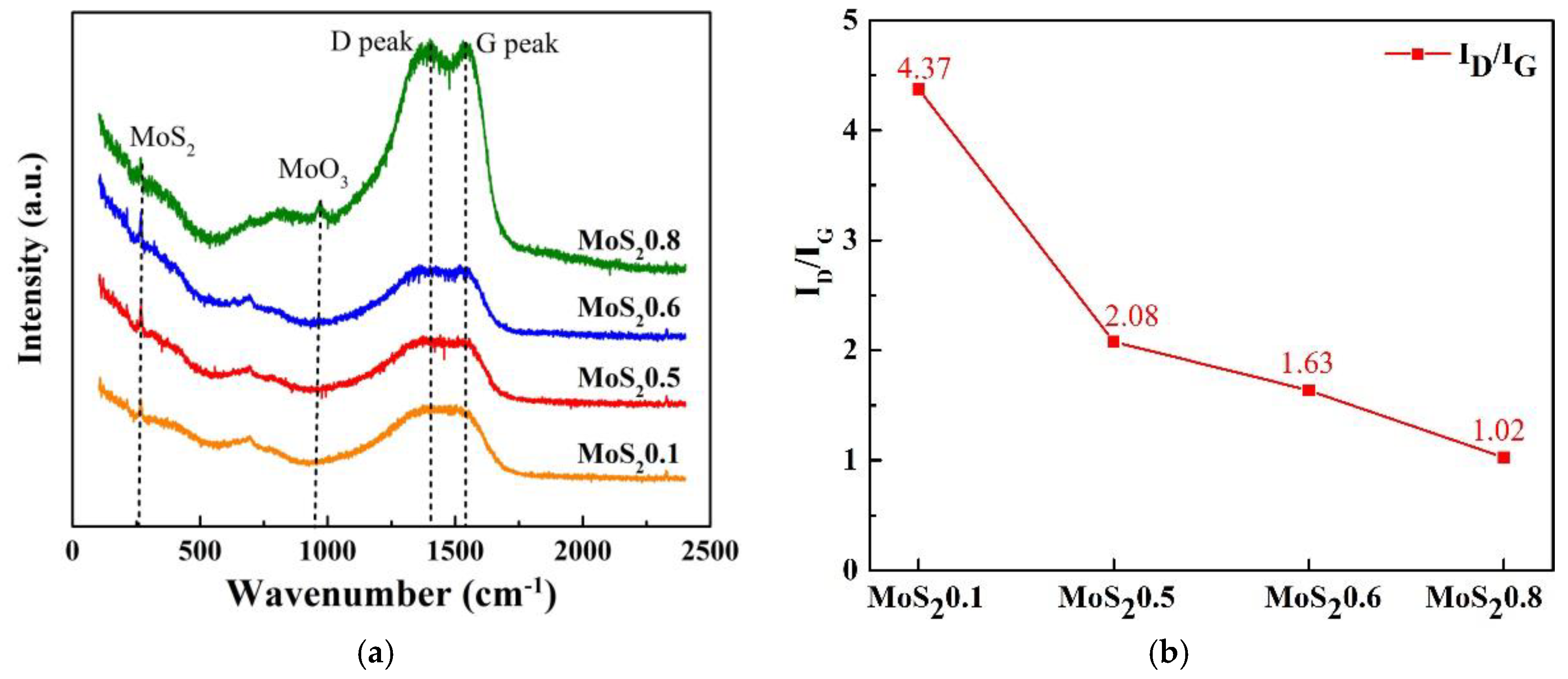

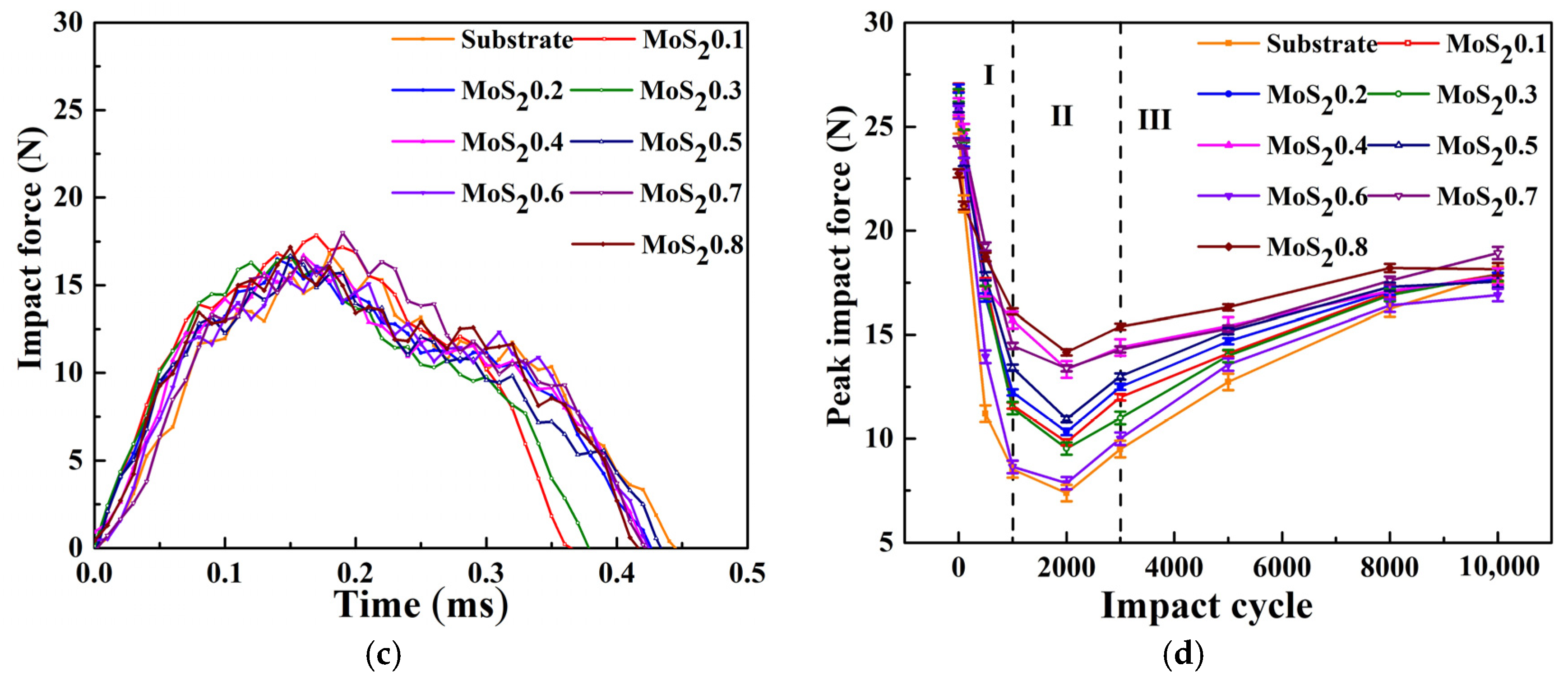
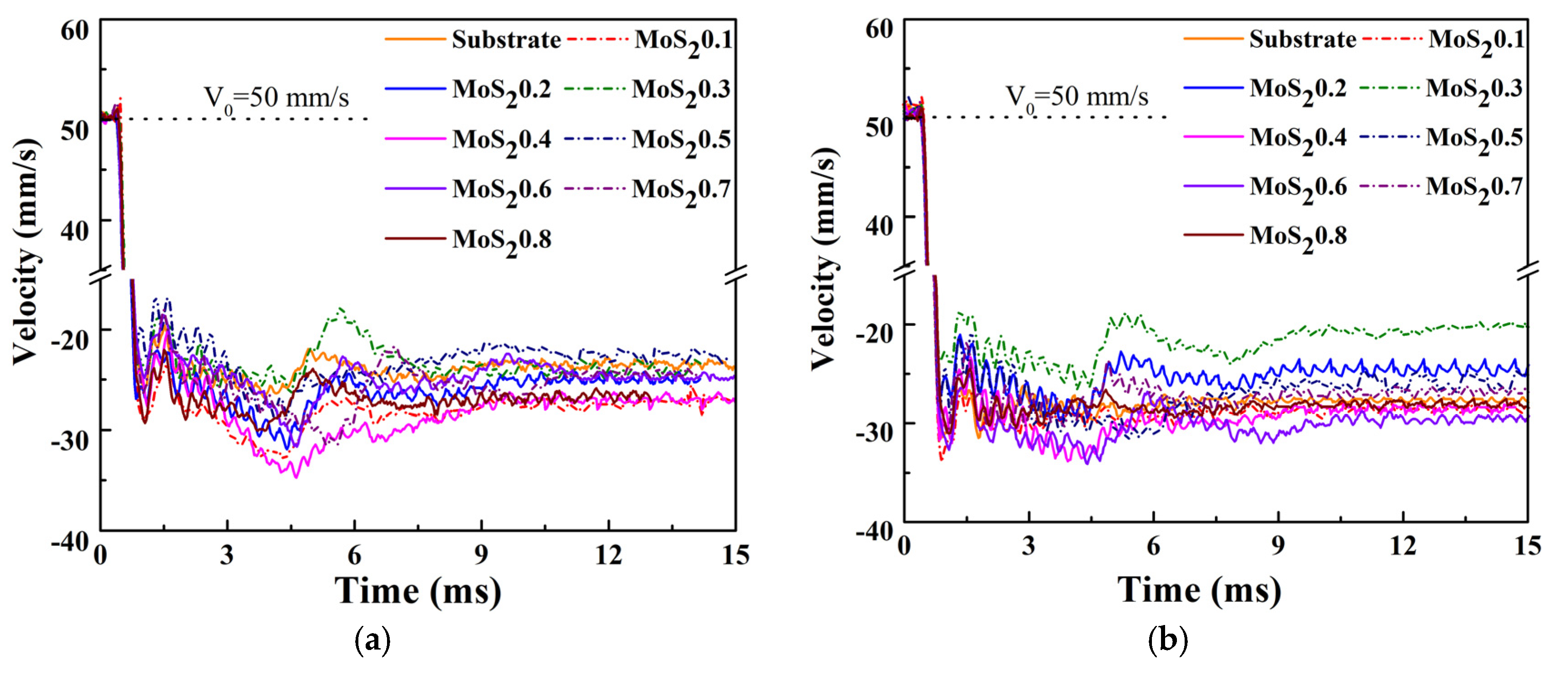
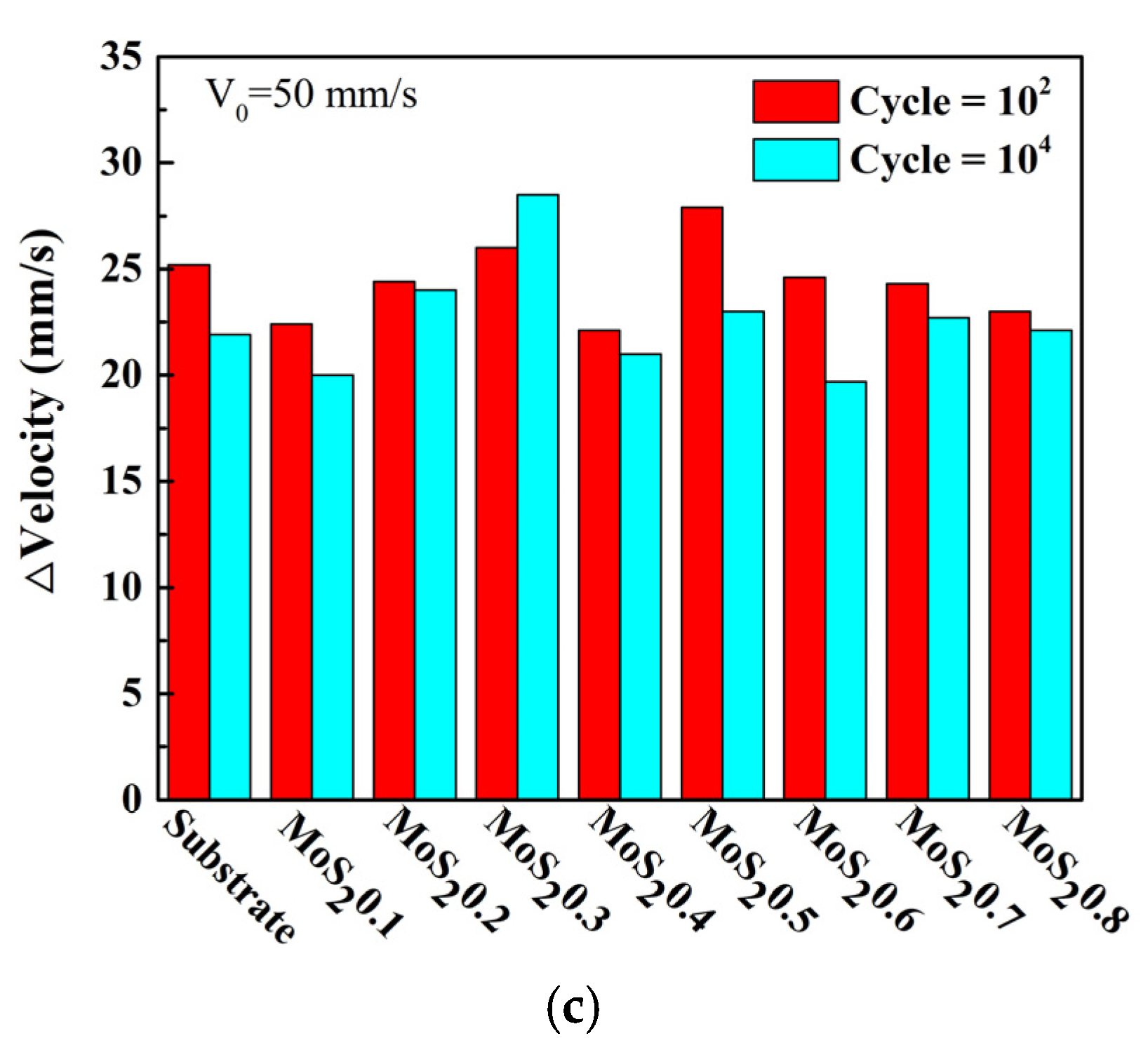
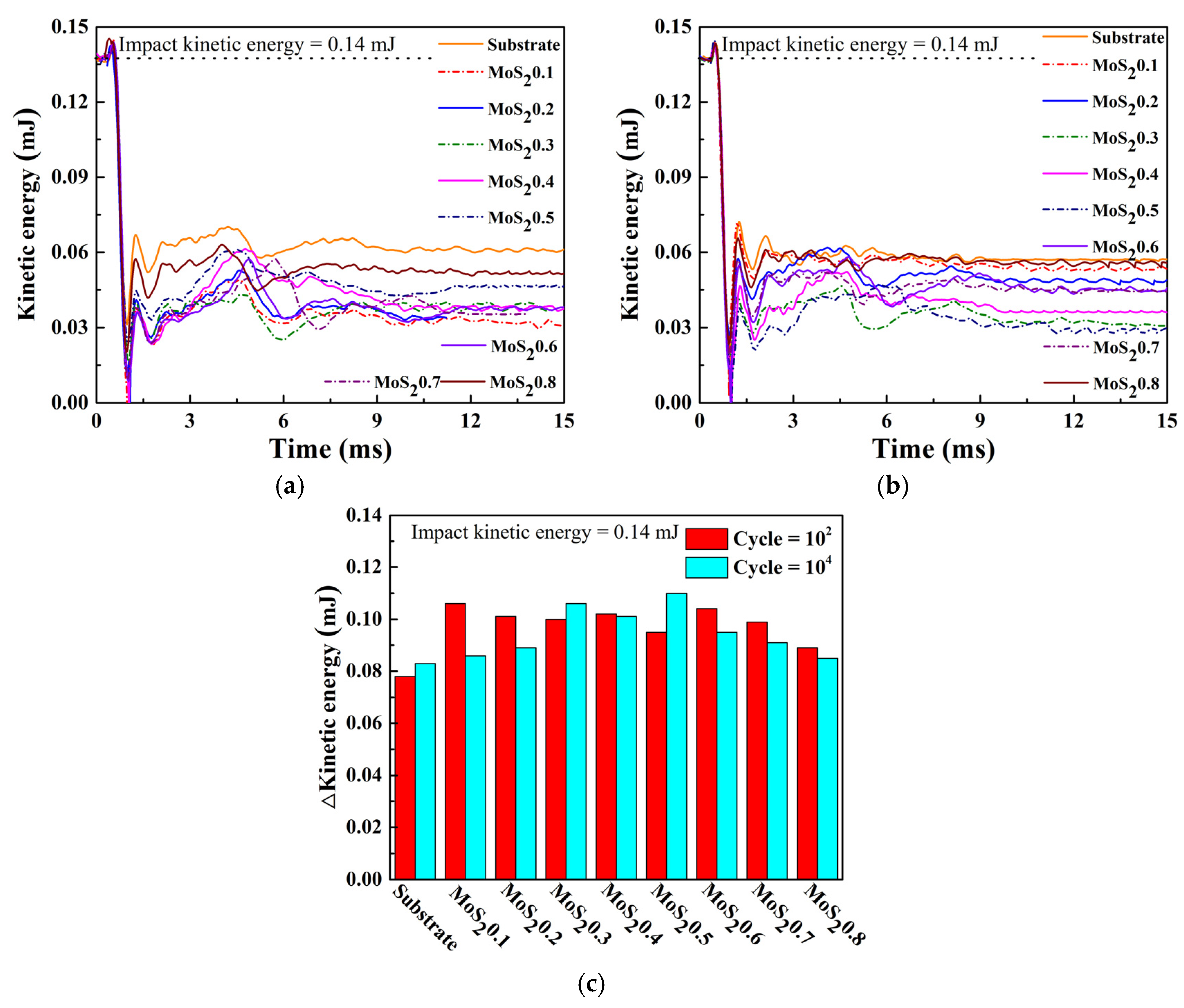
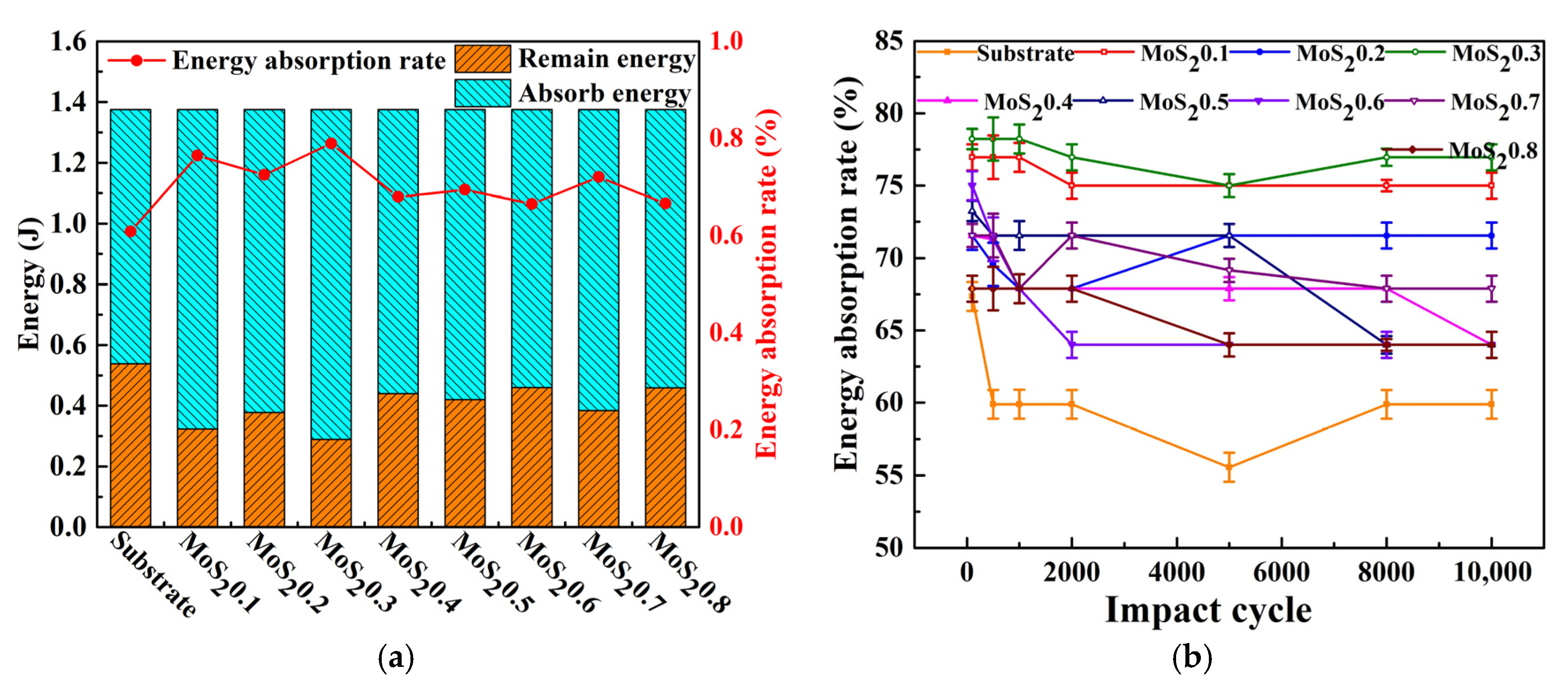
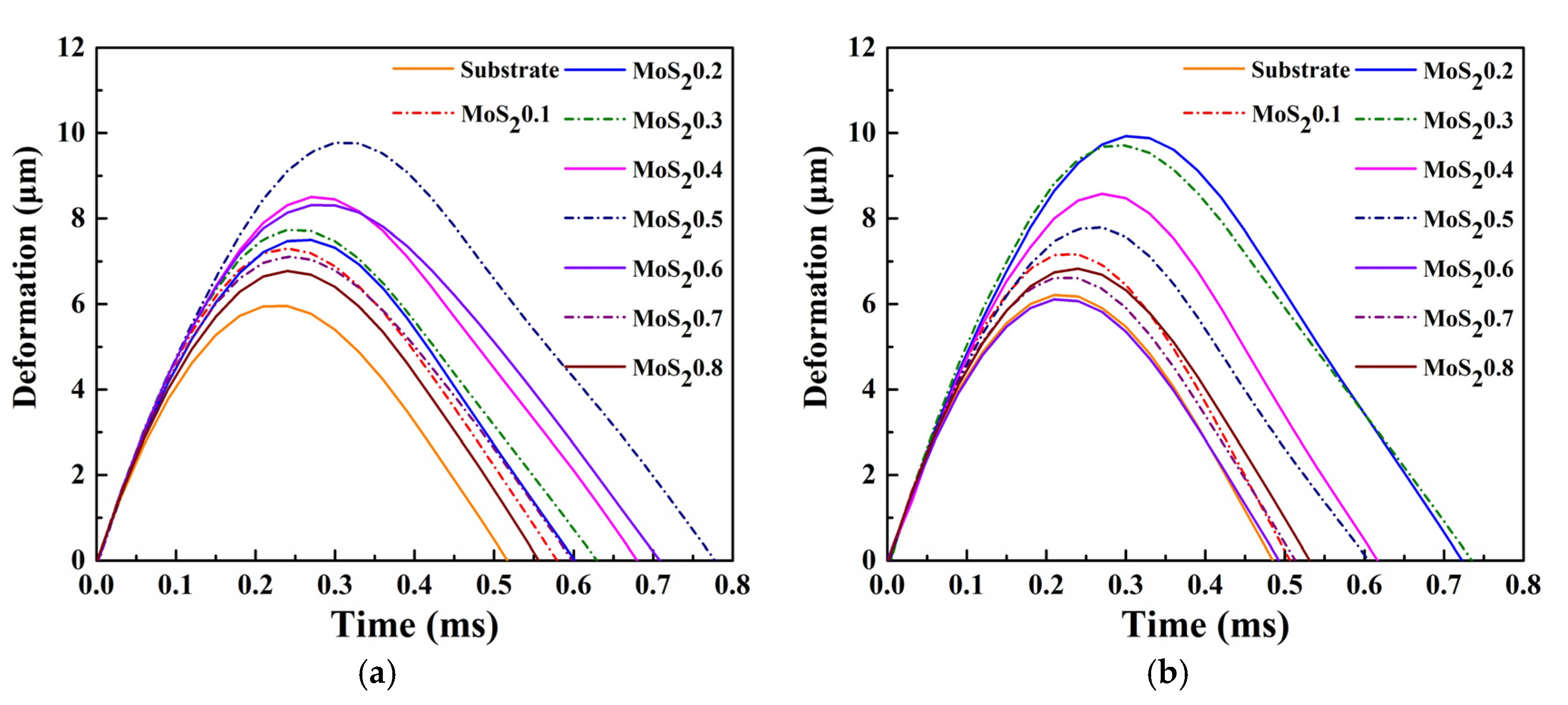
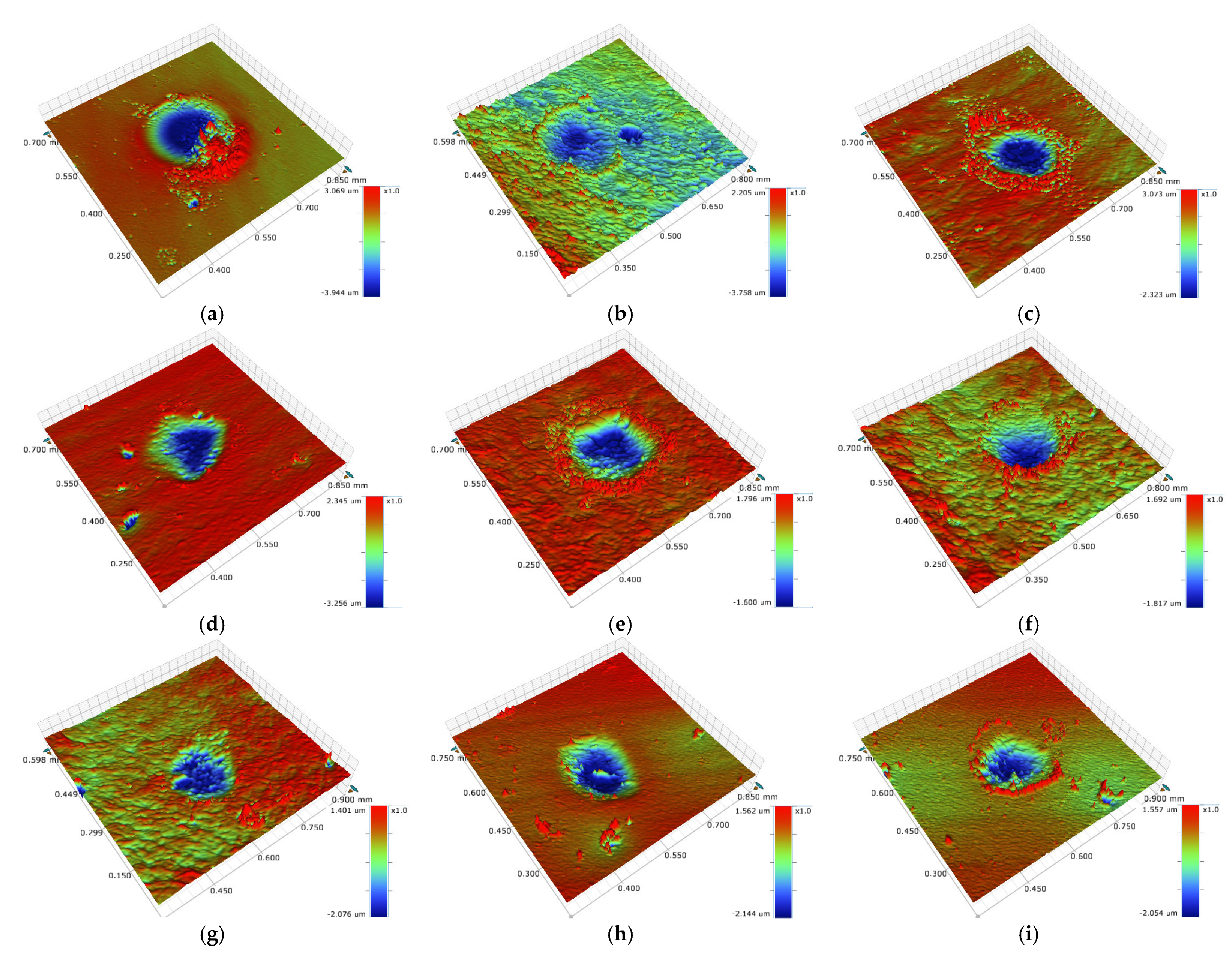

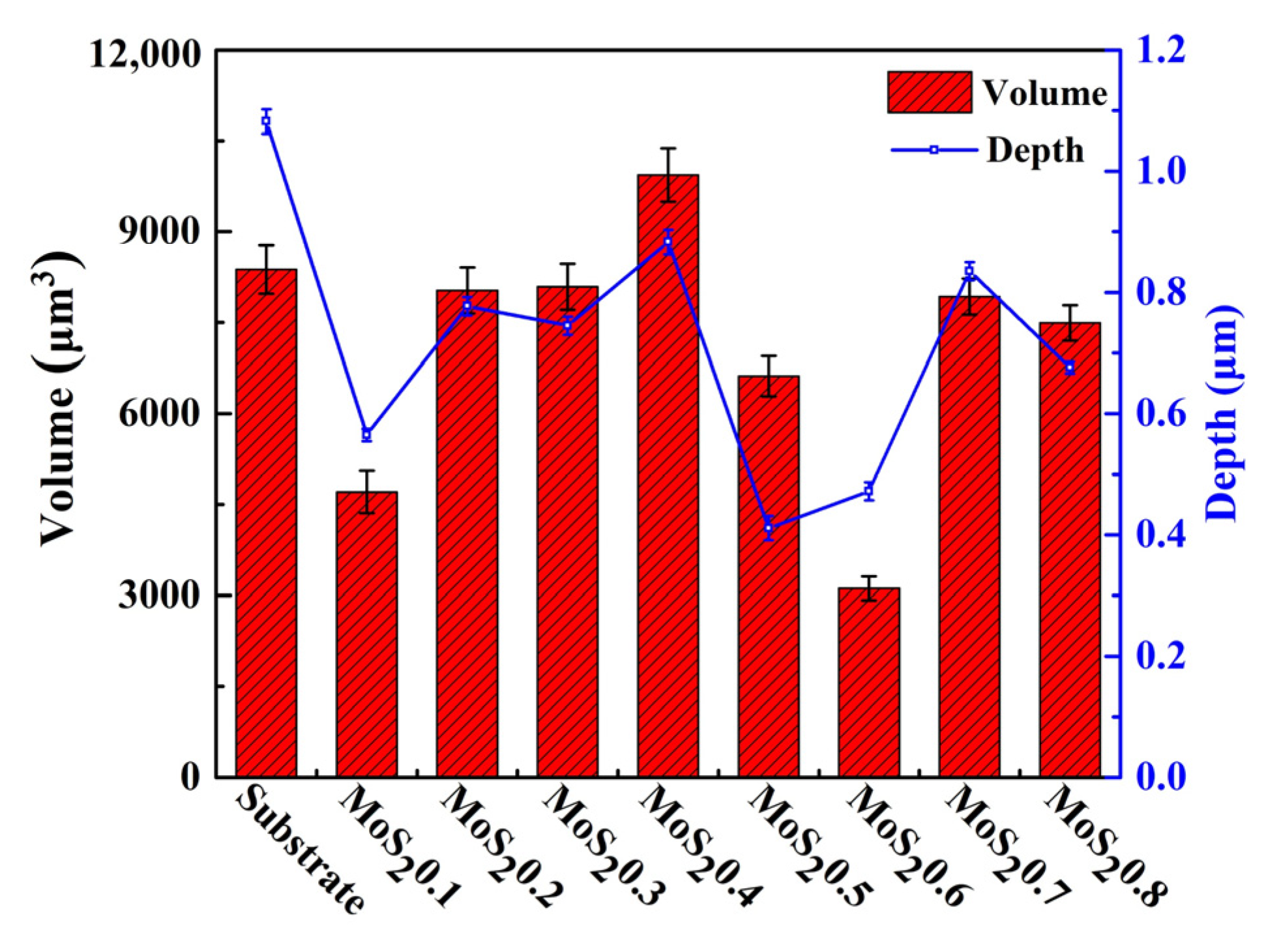


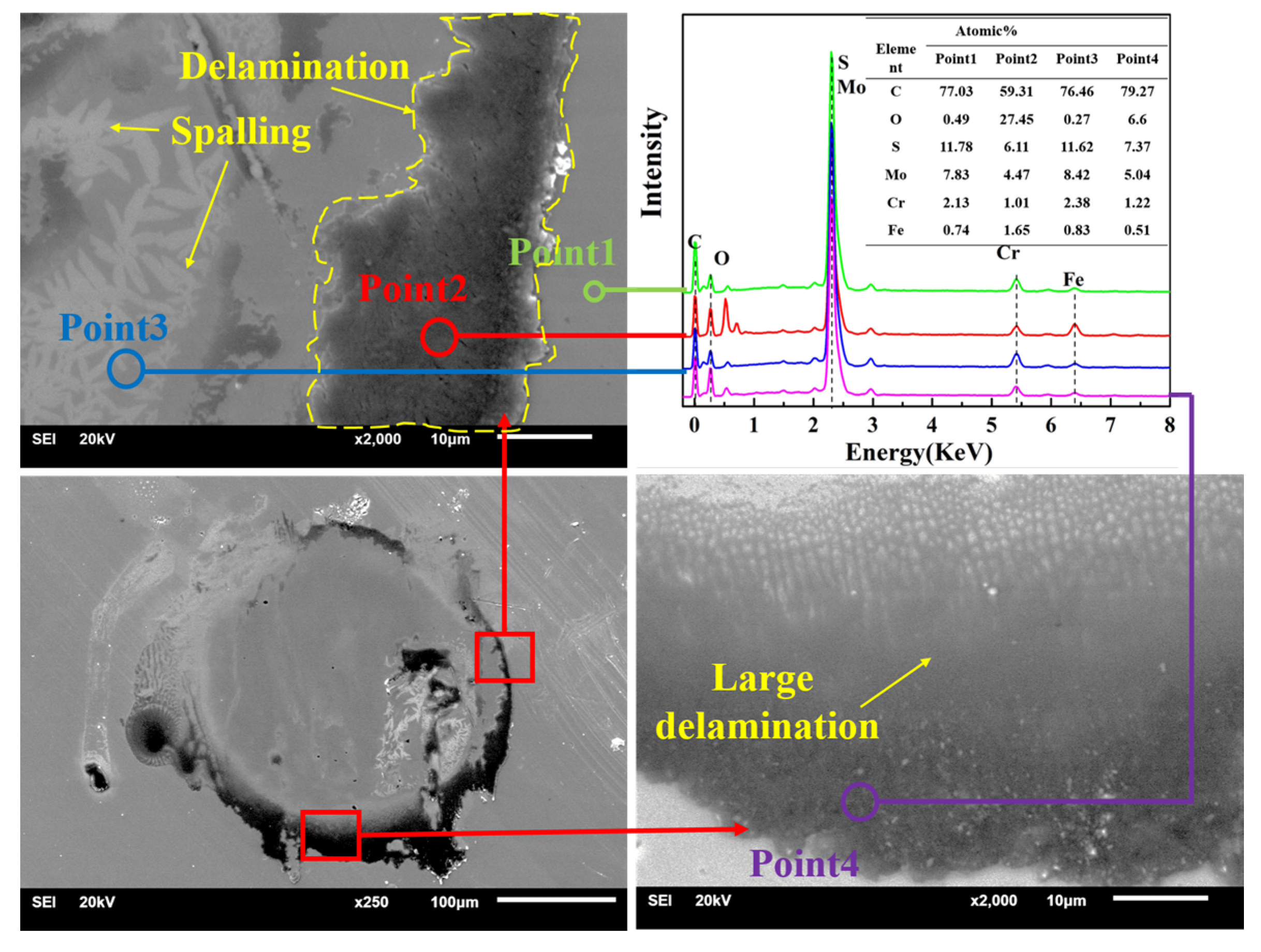
Publisher’s Note: MDPI stays neutral with regard to jurisdictional claims in published maps and institutional affiliations. |
© 2021 by the authors. Licensee MDPI, Basel, Switzerland. This article is an open access article distributed under the terms and conditions of the Creative Commons Attribution (CC BY) license (https://creativecommons.org/licenses/by/4.0/).
Share and Cite
Zhou, J.; Zhang, L.; Ding, Y.; Chen, X.; Cai, Z. Impact Fretting Wear of MoS2/C Nanocomposite Coating with Different Carbon Contents under Cycling Low Kinetic Energy. Nanomaterials 2021, 11, 2205. https://doi.org/10.3390/nano11092205
Zhou J, Zhang L, Ding Y, Chen X, Cai Z. Impact Fretting Wear of MoS2/C Nanocomposite Coating with Different Carbon Contents under Cycling Low Kinetic Energy. Nanomaterials. 2021; 11(9):2205. https://doi.org/10.3390/nano11092205
Chicago/Turabian StyleZhou, Junbo, Lin Zhang, Yuan Ding, Xudong Chen, and Zhenbing Cai. 2021. "Impact Fretting Wear of MoS2/C Nanocomposite Coating with Different Carbon Contents under Cycling Low Kinetic Energy" Nanomaterials 11, no. 9: 2205. https://doi.org/10.3390/nano11092205
APA StyleZhou, J., Zhang, L., Ding, Y., Chen, X., & Cai, Z. (2021). Impact Fretting Wear of MoS2/C Nanocomposite Coating with Different Carbon Contents under Cycling Low Kinetic Energy. Nanomaterials, 11(9), 2205. https://doi.org/10.3390/nano11092205





